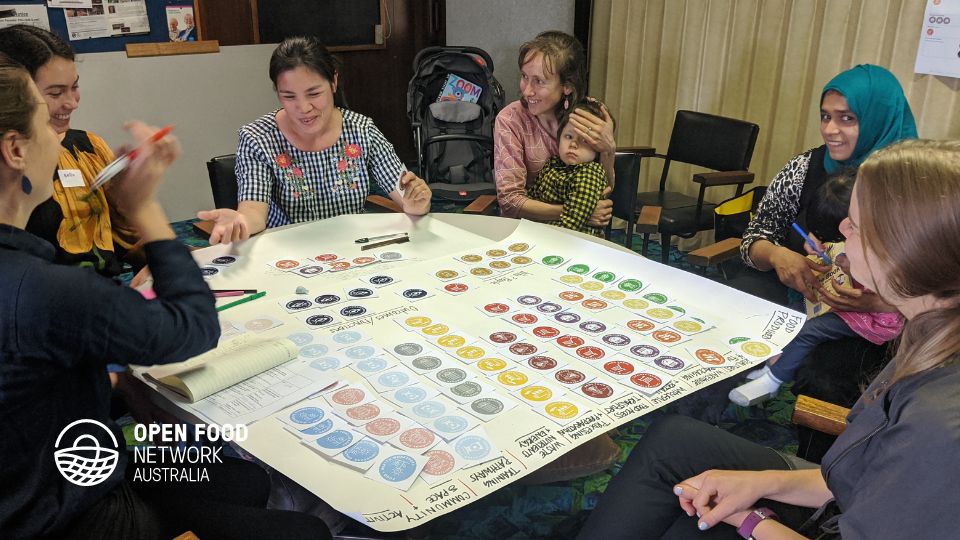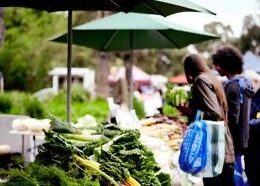Resources
How to co-design a food hub with your community

A food hub can play many roles in a community. It can help farmers sell food for a fair price, bringing together produce from many farmers to make it easier to sell produce. It can source food that is culturally important to a particular group of eaters, or provide access to food for all, no matter their financial circumstances. It can create a community place, a food processing facility, a teaching space, and more. The needs of each community are unique.
Co-design is a process that enables communities to design something that meets their needs, but also to build their understanding of their fellow community members through the process. The community members who join the process may have passionately held views that differ from others’ understanding of the challenge, but through the co-design process everyone develops empathy for the needs of others in their community. Often (and ideally!) this leads to a communal understanding about what to prioritise.
These workshop materials can help you run a food hub co-design process with your community. They’re just a couple of the activities that we use when running co-design processes – there are many more! If you would like us to run a food hub co-design process in your community, get in touch.
This methodology and these materials were first developed by Open Food Network and Fair Share Fare as part of a project in the City of Moreland to co-design a food hub, and we’ve refined them with numerous communities in the years since. They are licensed under Common Copyright CC BY-NC-SA 4.0 and you can see the appropriate attributions for this methodology and the supporting materials at the end of this article. We’re publishing them as part of our belief in open source food systems.
Co-design a food hub with your community
These are the key factors to consider when co-designing a food hub with your community.
1.) Bring together diverse perspectives
Make sure that your co-design process includes many different voices from your community, in particular ensuring that anyone impacted by what you’re designing is included in the process – a key co-design principle is ‘nothing about us, without us’.
We often use a range of recruitment strategies, including identifying community pollinators/gatekeepers to different communities, advertising (including in a variety of languages and channels), undertaking research interviews and snowball sampling (asking each participant you speak to ‘who else should we speak to?’). Where the co-design process will be a smaller, multi-workshop process we might have an open invite ‘feeder’ event as well, and through all of these channels we will try to pull together a group of people who represent diverse perspectives across the community who want to address the challenge we’re trying to solve.
2.) Get the background info – and use it!
Use a variety of research techniques, such as surveys and interviews, to understand which issues might be important to design for in your community. Make sure that what you learn through this process is used to inform the activities you undertake through the co-design process, e.g. if you hear in research interviews that a lack of car access is a key thing affecting food security in your community, and they hope a food hub will solve this issue, you might want to prepare co-design activities that pay particular attention to that challenge.
3.) Use the food hub design game to build a picture of your community’s priorities
We developed this game to help people – however familiar or unfamiliar they are with food hubs – to articulate what they thought was most important for a food hub in their community.
We recommend a workshop of no more than 30 people, in groups of 4-6 for this activity. Set each group up around a table with a large sheet of paper, pens, blu-tack, post-it notes, and a bundle of food hub design cards (cut out the sheets so that each image is on its own card).
The first step is a presentation, explaining some of the concepts included on the playing cards.
Then, ask table groups to work on developing their food hub vision together. Either people can take turns around the table picking the most important element to them first and add that to the centre of the paper (sticking it down with blu-tack), and you can continue to build out from those core elements, or some groups prefer to systematically work through the deck of cards deciding which ones are important to them.
Ask the team to group their elements as they go, or draw lines between related elements (e.g. perhaps a particular outcome is reliant on a particular piece of infrastructure). They can also create elements they think are missing by adding post-its.
Part way through the activity prompt groups to ensure that they cover off the ‘Outcomes’ and ‘Operations’ cards – it’s important to know who will do the work, and why.
Have each table group report back to the whole workshop, explaining some of their key decisions.
4.) Use other visual tools and co-design activities to help develop the picture
If you’re working with a geographic area, you might like to print out maps and ask people to identify key features that are important to your community’s food hub – e.g. places they access regularly, that have good transport, that are near particular transport routes, or community gathering points.
You can also use activities like persona development to help develop a picture of who the community food will serve, what their needs and habits are, etc.
5.) Narrow the scope
Often a community will want to do everything – why wouldn’t you?! It all sounds great! But usually there isn’t energy or budget to do that, so undertake some prioritisation activities to help bring things back to a feasible (but ambitious!) scope. This might be asking people to use dot-voting to nominate what their Minimum Viable Product is, or asking people to create a backcasting timeline with development of their hub and the steps needed along the way, including who will do the work.
6.) A final reflective activity
We often finish a workshop with a personal reflection written activity which allows people to articulate their vision for a food hub, now that they have worked with their community and developed understanding of others’ needs. This can be valuable for ensuring all voices are heard. Prompts might include things like ‘When I’m at a my food hub I (see/hear/smell/meet)…’; ‘I go to my food hub…’; etc. and will also usually include something that allows them to indicate what their role was in creating the food hub, and whether they are happy to be contacted to help further develop the food hub.
7.) Document and report back
Make sure you document what was discussed at each table, in the group, and gather all individual feedback. Have a plan for how to record this information, how to report it back to participants, and what the next steps will be.
There are many other activities that can help a community co-design a food hub, and the process relies on strong preparation and great facilitation.
You are welcome to use some of these techniques and materials for non-commercial use, attributing their development to our team at Open Food Network and Fair Share Fare (they’re licensed under CC BY-NC-SA 4.0), or you can contact us to run a process like this in your community.
This methodology was developed by Jen Sheridan, Jen Rae, and Kirsten Larsen, and should be attributed to as such.
This iteration of design cards you can download here was further refined by Jen Rae, Abby Christiaans, Ayra Clark and Helene Hartung.
Latest Resources
Can we help?
Have an idea, a project or a question? Want help using the Open Food Network software? Get in touch and find out how we can help you with it.
Keep in touch
Join us
Create a listing, shop or group directory on the Open Food Network. Tell me more!

Read our Terms and conditions | Find us on GitHub
Open Food Network is a free and open source software platform. Our content is licensed with CC BY-SA 3.0 and our code with AGPL 3.
We take good care of your data. See our cookies policy
Open Food Network respectfully acknowledges the traditional custodians of the unceded lands on which we meet, work and live. We pay our respects to their Elders, past, present and emerging and acknowledge their deep spiritual relationship to country.




